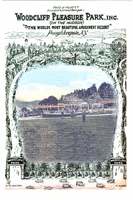Woodcliff Pleasure Park
Shortly after Harriet Winslow died in 1926 her daughter and adopted son sold the property to John Marian, a Poughkeepsie real estate developer (see note 1).
By December 1926 the Marians sold the property to Fred H Ponty of Rye NY (see note 2). Ponty had developed an amusement park in Rye which became Playland a locally famous attraction after he disposed of his interest in the operation. He envisioned a Poughkeepsie in a grander scale. He kept most of the landscaping, but instituted several rides, including a roller coaster which was noted for the steepest decline in the USA. He also constructed a swimming pool capable of handling 3000 bathers. There were several other rides and concession stands. There was an outdoor dance area, and another dance area inside the Winslow house which also included a restaurant.
Ponty financed the plan by leasing space to the rides and concession stands. He transferred ownership of the land itself to a separate corporation Woodcliff Pleasure Park (see note 3). The arrival of the Great Depression did not help matters, and the park went into bankruptcy in 1934, when the grounds were taken over by Wesley Ruthkowski, who promptly flipped them to Runk Realty Corporation, a local realtor in Hyde Park (see note 4). However the land sale was subject to requirement that the new owners honor the existing leases for the rides. The roller coaster had a lease until 1938 with an option for a five year renewal, so the amusement park would remain open until 1941.
In 1934 Tempa E Dyruff was awarded interest in much of the equipment of the park, and in 1935 acquired the land which was to become Western Publishing Company, a part of which was leased for parking for the Woodcliff Pleasure Park. see note 32 Some of the things she acquired were 1500 bathing suits and 1000 towels from the pool, the cars on several of the rides, and concession stands (see notes 5-6).
The Park operated until 1941. Much of its business was via the Hudson River Dayliner Trips from New York City. The Dayliners could dock at a dock at the Park (whether this was built by the Park or by Winslow is not clear), and a staircase would take them up to the park. Management was not too precise. On one occasion the managers granted exclusive use of the restaurant and former Winslow home to a group from New York City and exclusive use of the same space to the Polish American Club of Poughkeepsie. A riot ensued and the park soon closed (see note 7).
The park remained closed. Part of the operation was dismantled. The Marist Brothers recovered some of the curved beams from the main roller coaster and used it as a roof for a small building which housed their cannery and beehive maintenance equipment. But vandalism soon changed the property into an eyesore. Eventually Runk Realty found a buyer: Kem Plastic Playing Cards of New York City.
Note 1 1926 liber 465 page 425 Thomas Scudder Winslow to John E Marian & wife
Note 2 1926 31 dec 1926 liber 475 page 250 John & Elizabeth Marian to Fred H Ponty
Note 3 1930 liber 511 page 44 Fred H Ponty to WoodCliff Pleasure Park
Note 4 1934 liber 537 page 65 Woodcliff Pleasure Park to Wesley Ruthkowski
1934 liber 539 page 97 Wesley Ruthkowski to Runk Realty Corporation. Wesley's wife, Fran Ruthkowski was a principal in Runk Realty Corporation.
Note 5 1935 liber 566 pages 566 & 533 Ponty /Woodcliff Pleasure Park to Tempa E Dryuff
1936 liber 604 page 570 Dutchess County Sheriff to Tempa E Dryuff
Note 6 Wesley and Barbara H. Gottlock in Amusement Parks of the Hudson Valley describe it a little differently on page 60. “Woodcliff tried to buck the economic trend and in 1934 it opened under new management headed by Brooklyn attorney Nicholas Dyruff. Title was eventually passed to Tempa E. Dyruff who bought the park at public auction on June 4, 1935 as Ponty’s mortgage went into foreclosure. Nicholas Dyruff overhauled all of the rides, brought in a few new attractions, including a new roller skating rink, updated the swimming pool, and groomed the gardens and picnic areas. The refurbished Woodcliff Inn would now operate under separate management and it would expand to include an outdoor beer garden and dance area. The Twister coaster was added in 1938. Apparently it was not enough. The park struggled along into 1941.
Note 7 A reader interested in a more complete story of Woodcliff Pleasure Park may check two recent books now in the Archives Section of the Marist College Library: Carney Rhinevault and Tatiana Rhinevault, Hidden History of the Mid-Hudson Valley, Stories from the Albany Post Road, The History Press, Charleston SC, © 2011 by the authors, pp 133-143, The Rise and Fall of Woodcliff Pleasure Park; and Wesley and Barbara H. Gottlock, Lost Amusement Parks of the Hudson Valley, © 2011 by the authors, pp. 53-78, Woodcliff Pleasure Park.
Research on this project was conducted from January 2008 through August 2012 by Richard Foy, assisted by student assistants Paul Contarino and Kayla Benefield. (Source: Marist College Land History: Winslow Parcel)
Marist University | Marist Archives & Special Collections | Contact Us | Acknowledgements

